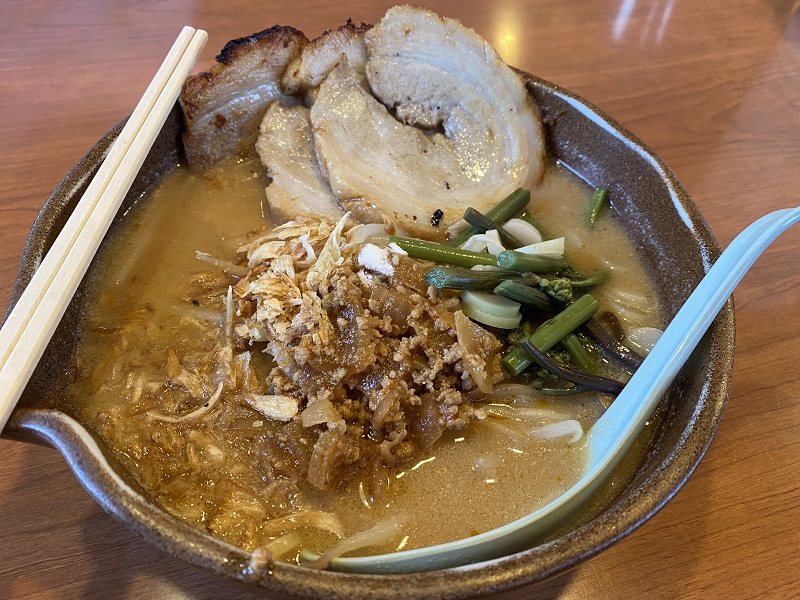9 of Nagano's Best Local Foods
Enjoy some of the most delicious local dishes and snacks from around Nagano.
Update:2020/06/16

When you travel somewhere new, you want to try all of the foods that the area has to offer. Why would you eat the same things wherever you go?
Japan is known for its delicious food, from sushi and sashimi to ramen and udon. In addition to these well-known delicacies, there is a wide variety of regional foods that you can only get in certain areas of Japan.
Nagano, located in the mountains in central Honshu, has long been an important hub for trade and travel, and over the centuries, developed its own unique cuisine. When you come to visit, whether to see the snow monkeys or to visit Matsumoto Castle, be sure to try some of the dishes below!
The best local foods to eat in Nagano
- Sauce Katsudon
- Oyaki
- Gyunyu Pan
- Gohei Mochi
- Shinshu Miso ramen
- Mountain Vegetables
- Basashi
- Sanzoku-yaki
- Soba Noodles
Sauce Katsudon

Tonkatsu is one of Japan's most popular comfort foods. You can eat it plain, serve it with curry or even turn it into a sandwich. Many places in Japan have their own takes on tonkatsu, and Nagano is no different.
Sauce katsudon is Komagane's version of the popular dish. Pork cutlet is fried, dipped in a rich brown sauce and served over a bed of rice and cabbage. Fresh pork and a flavorful, but not overpowering, sauce is the key to a good sauce katsudon.
The most famous sauce katsudon restaurant in Nagano is Meiji-tei. In addition to their original locations in Komagane, they also have shops in Nagano City and Karuizawa as well. If you like the flavor of their specially made sauce, you can even buy some to take home!
Oyaki Dumplings

The original Nagano snack food, this flour dumpling is filled with vegetables and then steamed, char-grilled or fried to perfection.
Common fillings include nozawana pickles, miso-marinated eggplant, shredded daikon radish, and mashed pumpkin. They’re a delicious snack option that just happens to be vegetarian as well!
Oyaki are also surprisingly easy to make, either at home or with help at one of Nagano's historical oyaki shops.
Gyunyu Pan (Milk Bread)

This simple, sweet snack is a Nagano favorite.
Rich cream is sandwiched between two pieces of fluffy bread and cut into rectangular loaves. The bread itself is made with milk, which is how gyunyu pan (or "milk bread") gets its name.
Some say that gyunyu pan was invented at the Kanemaru Bakery in the town of Kiso Fukushima, but now almost every bakery around Nagano makes its own—you can even find it in convenience stores and super markets around the prefecture.
Gohei Mochi

This half-pounded rice mochi is roasted and covered in a sweet-and-savory sauce, usually made with miso, walnuts, or egoma (perilla).
It is a popular snack in the Kiso Valley, and you can find shops selling gohei mochi around the post towns of the Nakasendo. Each post town has their own flavor and shape of gohei mochi, so it's worth trying another at each one you visit.
Shinshu Miso Ramen

Did you know that Nagano Prefecture produces the most miso out of any prefecture in Japan? Nagano is responsible for 40% of the country’s miso production, so it’s only natural that Naganites enjoy their ramen with a rich, miso-based broth.
Some easy-to-access places known for their miso ramen include Ramen Misoya near Nagano Station and Sakura near Matsumoto Station.
Mountain Vegetables

Mountain vegetables are delicate yet packed with flavor, making them a delicacy around Japan. If you happen to be in Nagano during spring, you may have the chance to eat some of these wild vegetables that locals pick from the mountains.
They are often boiled or pickled and served as side dishes, but also make an excellent main dish when fried in tempura batter.
Some of the most popular varieties include kogomi (fiddlehead fern), warabi (common bracken), koshiabura, fukinoto (butterbur) and tara-no-me (Japanese angelica tree shoots).
They are usually available between April to the end of June.
Basashi

Being a landlocked prefecture, Nagano isn't known for its seafood, so when you get a hankering for sashimi, sometimes you have to try other options.
Basashi is one such option. Like sashimi, it's thinly sliced and raw, but it just so happens to be horsemeat and not fish.
The most common cut of basashi is the akami, or lean cut, which you can find in many izakayas around Nagano. If you visit a restaurant that specializes in basashi, you'll also find rarer, fatty cuts including belly and neck meat.
Sanzoku-yaki Fried Chicken

Fried chicken is delicious enough as is, but this version is even better thanks to a marinade of garlic, onion and soy sauce.
Sanzoku-yaki is said to originate in Matsumoto or Shiojiri, but has since become popular prefecture-wide. You can find sanzoku-yaki dishes in most izakaya pubs around Nagano, as well as restaurants that serve local fare.
Soba Noodles

When you ask someone in Japan where to find the best soba, nine out of ten will tell you the same thing: go to Nagano.
Due to the arid, mountainous terrain of Nagano, rice was difficult to grow while buckwheat spread like weeds. The seeds became a staple in locals' diets, either eaten as-is or ground into flour and made into dumplings (called “Sobagaki”). Over time, locals learned how to make soba flour into noodles and the rest is history.
There are many ways to eat soba noodles. You can have them served cold with dipping sauce on the side a la mori-soba or zaru-soba, or have them in a hot broth like in kakesoba. Some soba varieties even come with unique dipping sauces (like miso and walnut). For all you ever wanted to know about soba and maybe more, see here.












